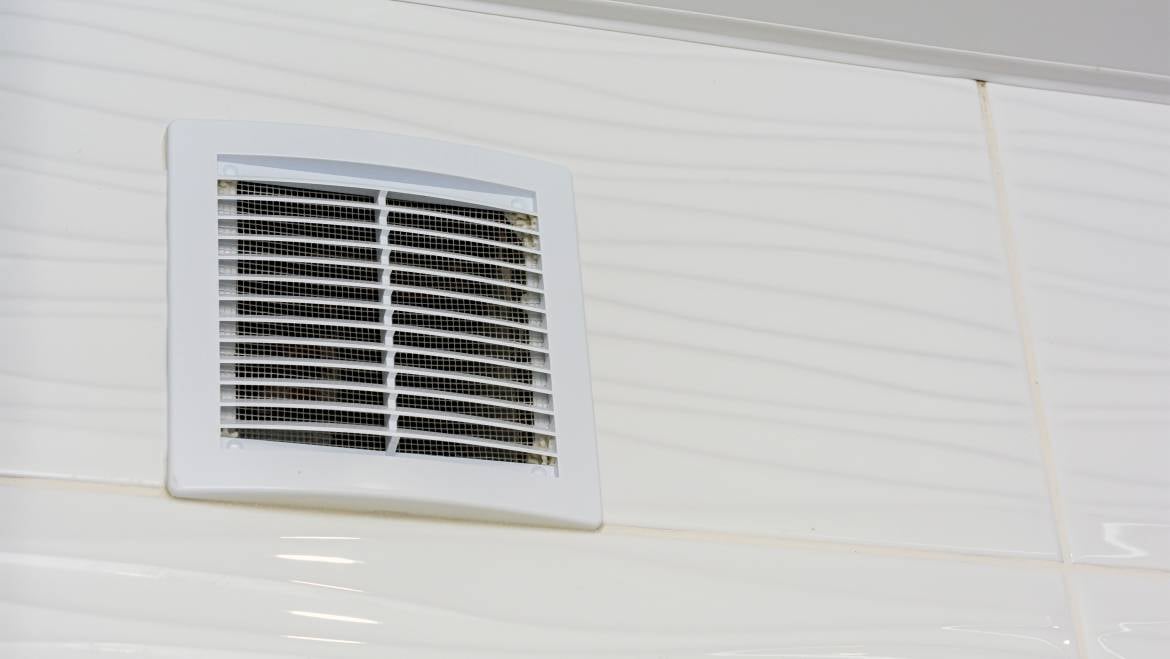How to Improve Bathroom Ventilation Problems
In most cases, bathroom ventilation systems don’t cause issues. The common build type includes a fan or fan/light being administered in the ceiling of your bathroom with a vent coming from the roof, soffit, or the side of a wall.
By hitting your switch you can quickly remove odors and unwanted moisture from the space. But how do you compensate for a building that’s design makes it a challenge to easily vent your bath fan outside?
In fact this is a common issue that occurs turning this simple process into a more complicated one. The solution to these types of problems involve creativity on the behalf of the construction team, advanced material knowledge and an experienced HVAC professional.
Dealing with Bathroom Ventilation and Building Code
Having a knowledge base surrounding history and code requirements will help you understand difficult bathroom ventilation issues before moving forward with solutions. Ironically before indoor plumbing was even thought of, people knew outhouses should have some sort of ventilation.
After we started to put bathrooms inside our homes, ventilation was imperative not only to remove bad smells but also to get rid of unwanted moisture. Everyone has experienced the amount of moisture that is prevalent when taking a hot shower. Now imagine how foggy your mirror gets and the condensation that is produced on windows and walls during a cold season.
As of now, building codes that are active in many municipalities mandate that bathrooms have ventilation powered by exhaust fans or a functional window. Window ventilation is the least work that can be done in order for the standards to be met but is not considered reliable or effective. Relying on a window being opened to remove excess moisture is a wild thing to ask for especially when temperatures are low. Having a fan vent is the better option in almost every scenario.
Signs of Bathroom Ventilation Problems
Modern houses are built with much more insulation than those from the past. There is a mandate that states “build tight and insulate right” and it has several advantages: more convenience for an interior (this is even more true during hot months), energy and field savings and minimizing carbon emissions.
However, tighter structures can lead to more air pollution taking place inside of your home. Mold spores are a dangerous air pollutant which comes from excess moisture. Mold can cause terrible health problems for you and your family and cause different respiratory conditions to arise as well as allergic reactions. Mold is also known to cause damage and deteriorate building resources such as wood and gypsum board.
Plumbing leaks are often the source of mold problems that show up in your bathroom. These can be identified by stains on your walls or ceiling which ultimately means you have a ventilation problem taking place. Your attic or other rooms above your bathroom can also be affected by mold. Mold is often not visible by the naked eye, but it is easily identifiable by odor that it brings along with it.
Even though there are many different reasons to check on your bathroom ventilation issues including foggy mirrors in some cases, mold is by far the most dangerous.
Basic Guidelines for Bath Fans
We will now discuss some components of bath fans and how they affect the performance of your ventilation system that is a key part to your bathroom remodel. Knowing key details about these elements gives you the ability to make sound choices when combatting your bathroom ventilation issues in any situation both simple and complex.
Buy the right fan
A bath fan is usually made in accordance to the amount of air they can push which is measured using cubic feet per minute or cfm. The mandate states that you should have at least 1 cfm per square foot of floor space of your bathroom. Because of this you probably should aim for the high side of this requirement and this is definitely true for bathrooms that are used frequently or have higher ceilings so think about this before getting your bathroom remodeling project underway. Cheap options are louder than the more expensive ones that are engineered to be as quiet as possible. Check for a sone rating of about 1 over anything at a 3 or a 4.
Consider special features
A key idea you should focus on for your bathroom renovation is if you want to get a bath fan that comes with a light to keep you from having to implement another fixture on your ceiling. A fan that has multiple speed modes gives you the ability to exert more exhaust power for extra humidity. This is useful for when you are taking a long shower or you are using it for a jetted tub. An extra measure of caution you can take is to get a bath fan that comes with a humidistat which gives you the ability to monitor your humidity level and automatically adjust to this.
An optimal environment for one of these is for a rental property when you are unsure whether the tenant will operate the ventilation system accordingly. The main points you need to take from this information are that every fan is different and the value they will add to your living space is based on their price, use case and functionality. Choosing to go with a fan that comes with additional features can prove valuable for your bathroom refinishing project when dealing with challenging environments.
Use metal or PVC for ductwork
Do not use cheap alternatives for flexible duct (“Flexduct”) when doing your bathroom remodel and installing your bathroom fan. Doing so can ruin your system by stopping the air flow due to constant tearing. For a solution that will keep you from spending more money on expensive repairs, constantly go with an option that fabricates your bath fan duct runs from rigid metal or PVC plastic.
Keep duct runs as short and straight as possible
This goes for all forms of ductwork. The longer a duct gets the more convoluted it gets. As directional changes occur, the fans must overexert themselves to push air. In cases where this is not possible it is a good idea to choose a bigger fan option.
Options for Fixing Bathroom Ventilation Problems
Every option that follows this statement related to bathroom remodeling is a proven solution to challenging bathroom ventilation issues. However these methods will work best if they are followed by a HVAC professional who has experience working with these systems.
Include a recirculating fan for half-bathrooms in your bathroom renovation plans. In this scenario bath fans fail to push air to the outside. What they do instead is move the air from the bathroom into a filter that will remove the odors for you. This alternative is great for half-bath options because there is no shower to create moisture in the environment.
Lower noise by including an inline fan. The longer the duct run is, the more elbows that will be present for the purpose of directional changes meaning it will use more exhaust power to do its job of pushing the air out of the space. A stronger fan that is good for these situations will add more noise than you may want. However you have the option to lower this noise by administering an inline fan at some point in the duct run that’s away from your occupied living space.
Vent under the floor to get outside. In the case that you may have a bathroom which is situated far away from surrounding walls making it hard to vent a fan through the roof. Sometimes this scenario can occur when there is a bath placed underneath a staircase or even in a modern building that has higher ceilings. Consult with a professional bathroom refinishing contractor about fabricating a duct run that will go from a fan placed on a bathroom wall, through the floor, and (between floor joists) out to an existing exterior wall. Place the fan near the top of the wall to give it the ability to absorb more warm, moist air and fabricate the duct run from rigid metal or PVC resources. Then configure a stronger fan to combat convection. Then you want to exhaust the air down and out.
Create a soffit to mask the ductwork. Doing so gives you the ability to camouflage the duct run that goes to a bath fan inside a soffit placed on the interior wall.
Install commercial ductwork. One scenario where this might be the optimal alternative is when you have smaller apartments that are put into a larger building that has tall ceilings. In this situation you don’t want to fabricate separate long duct runs to the outside but instead you want to feed them into one long run that has a big diameter for commercial ductwork. In this case having this run be visible will add a stylistic appeal to your structure like in restaurants or retail stores.

